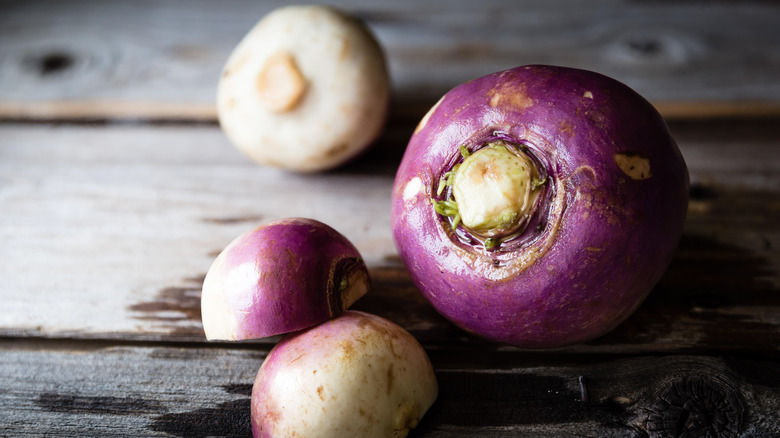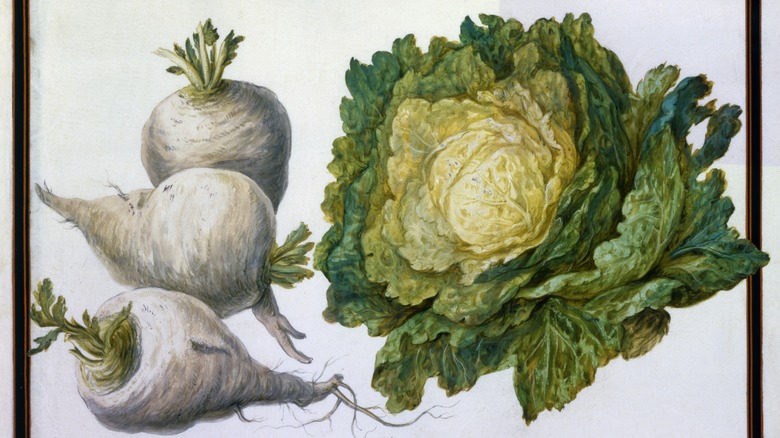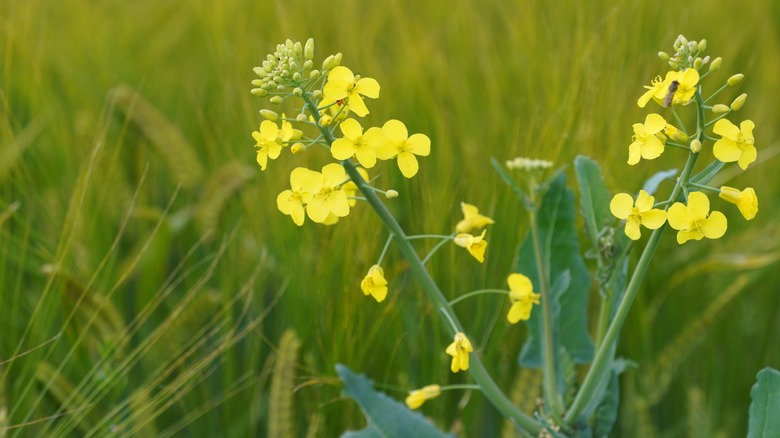Rutabagas Are A Hybrid Of These 2 Vegetables
It's perhaps hard to imagine a vegetable more humble than the rutabaga. Recette Magazine notes that the first written record of the rutabaga dates to 1620, when Gaspard Bauhin, a Swiss botanist, observed the root vegetable growing in Sweden. Rutabagas are believed to have originated somewhere in Scandinavia, Finland, or Russia, though no one is sure exactly when or where.
When rutabagas are prepared properly, as in a savory rutabaga and turnip gratin, or as The New Yorker writer Helen Rosner prefers them, as a pasta substitute in a heavenly rutabaga cacio e pepe, they can be utterly delicious. Like many root vegetables, rutabagas store well and were an important food source during the food shortages throughout Europe during the world wars, where, according to Recette Magazine, "rutabagas were deemed a last resort food and eaten in a paltry stew of rutabagas and water." American Heritage Vegetables explains that rutabagas were an important feed crop for cattle, which may have contributed to their lack of appeal at the dinner table.
But there's more to the humble rutabaga than you might imagine. In fact, this oft-overlooked root vegetable that Helen Rosner calls a "culinary underdog" is part of an interesting family, and it's a far more valuable crop than we might realize.
The rutabaga family tree
Edible Ojai and Ventura County explains that rutabagas are a hybrid of two familiar vegetables: The turnip and the cabbage. MasterClass points out that rutabagas are also called swedes, Swedish turnips, yellow turnips, turnips, or, if you happen to be in Scotland, neeps. Cabbage, turnips, and rutabagas are all part of the brassica family of plants, according to Harvesting History, a family that includes mustard, broccoli, cauliflower, and brussels sprouts, among others. Rutabagas are known, scientifically, as the Brassica napus species.
Though most sources simply explain that turnips and cabbage are the parents of rutabagas, or, as Helen Rosner poetically puts it, "Somewhere, in the misty meadows of Central Europe, a turnip got frisky with a cabbage, and the rutabaga was born," a 2019 study led by researchers from the University of Missouri found that the rutabaga's roots may be a little more complicated than we originally thought.
Researchers examined the genome of B. napus in its three most important forms, or morphotypes, and their conclusion is twofold. First, they argue that B. napus "has one of the most complex genomes among flowering plants," and second, they argue that the relationship of B. napus to turnips and cabbage is more akin to that of sisters, rather than parent and child. Researchers propose the most likely scenario is that rutabagas are really the descendent of "either an early form or an extinct ancestor" of turnips and cabbage.
What about those three forms of B. napus?
How is it that the rutabaga, with its humble reputation, is part of a species of plants worth roughly $41 billion each year, according to researchers from the University of Missouri? The answer lies in those three different forms, or morphotypes. It turns out that rutabagas, the root of the plant that looks something like a yellow turnip, are only one way we consume B. napus. The other two forms are known as Siberian kale, the leafy greens of the plant, and canola, the bright yellow flowers that yield seeds used for cooking oil, biodiesel, and animal feed.
These three distinct varieties of B. napus have been bred to produce these three different products, and while all three are genetically distinct, they're quite closely related. So close, in fact, that a 2020 study published in Crop Science explored the possibilities of crossbreeding rutabaga with canola to develop varieties with higher seed and oil yields. Canola, by the way, according to agronomist Gary Martens, was developed in Canada as a way to make rapeseed oil — used worldwide as an industrial oil — suitable for food use. Canada remains the largest producer of canola oil, followed by China and India.
Whether you're sauteing up some rutabaga greens to accompany your meal or pan-frying in canola oil, you're using a plant that's both more interesting and more valuable than most of us ever imagined.


